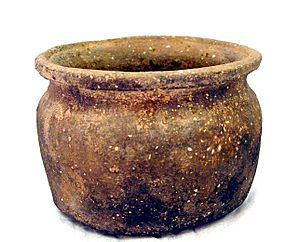Shelly ware facts for kids
Shelly ware is a special type of pottery found in Great Britain. It was used a long time ago, from the 600s to the 1100s! Imagine pots and jars made with tiny pieces of shell mixed into the clay. This made the pottery strong.
There are different kinds of Shelly ware, like Late Saxon Shelly ware and Early Medieval Shelly Ware. At first, people made these pots by hand. But after the 900s, they started using a spinning wheel to make them faster and more evenly. Shelly ware was made and sold in places like the Upper Thames Valley, near the coast in southeastern Britain, and in the East Midlands.
A Look Back: The History of Shelly Ware
When Was Shelly Ware Used?
The time when Shelly ware was popular is called the Anglo-Saxon era and the early Medieval period. The Anglo-Saxon era is split into three parts:
- Early Anglo-Saxon: From the mid-400s to the early 600s.
- Middle Anglo-Saxon: From the 600s to the 800s.
- Late Anglo-Saxon: From the 900s to the 1000s.
The Early Medieval period for pottery in Britain began in 1066, after the Norman Conquest. It lasted until the end of the 1100s.
How Shelly Ware Appeared
In southeast England, during the early and middle Anglo-Saxon times, people mostly used other types of pottery. These included sandy wares and Ipswich wares. But then, in the 600s, shell-tempered pottery, or "Shelly wares," started to appear. People kept using it until the late 800s.
Shelly Ware in Different Regions
Upper Thames Valley and London
Late Saxon Shelly Ware was made in the Upper Thames Valley. It was then sent to many places, including London. This type of pottery was very common in London from the late 800s to the early 1000s. Then, it suddenly stopped being used. Around the late 900s, a small amount of Early Medieval Sandy ware was also used alongside Late Saxon Shelly ware. Over time, Shelly ware changed into Early Medieval Shelly-Sandy ware in the 1000s.
East Midlands
In the East Midlands, Shelly wares were usually made and sold close to where they were found. Lincolnshire Shelly wares include different types. These are Lincolnshire Late Saxon Shelly ware and Lincolnshire Kiln type Shelly ware, which were used from the late 800s to the late 900s. There was also Early Lincoln shelly ware, used from the 900s to the 1000s.
What Shelly Ware Looks Like
Shelly wares are different kinds of pottery that all have crushed shell mixed into their clay. This was done during the Anglo-Saxon and early medieval times in Britain. The pottery can be sorted into groups based on where it was found and when it was made. The shells used were either from the sea or fossil shells, depending on what was available nearby.
At first, Shelly ware was usually made by hand and fired in a bonfire. This was true until the early 900s. But by the mid-900s, potters in the East Midlands, Upper Thames Valley, and southeastern England started using a pottery wheel. This made making pots much faster.
Types of Shelly Ware
Late Saxon Shelly Ware
Late Saxon Shelly ware was very common in London from the late 800s to the mid-1000s. The clay of this pottery has many small pieces of shell. If you look closely with a microscope, you can see these shells are set in a chalky material. This pottery was found in many places in the Upper Thames Valley. It looks similar to Surrey whitewares. Most of the pieces found are jars and bowls.
Early Medieval Shelly Ware
Early Medieval Shelly ware is similar to Late Saxon Shelly ware. However, the shells in the medieval type are usually from bivalves (like clams or mussels). The clay also often has small bits of flint and quartz. Early Medieval shelly ware also looks a bit like Surrey whitewares. The walls of these pots are usually thinner than older Shelly ware. It was commonly used from the mid-1000s to the mid-1100s.
Lincolnshire Shelly Wares
Lincolnshire Late Saxon Shelly ware is usually hard and has a fine texture. The pottery can be brown, reddish-brown, or dark grey. Lincolnshire Kiln-Type Shelly ware and Lincoln Early Shelly wares are grey. They have a few shells and quartz sand mixed in. They also contain iron and were fired at high temperatures. They have some rough sand and sometimes larger quartz pieces.
See also
- Sandy ware
- Ipswich ware
- List of English medieval pottery



